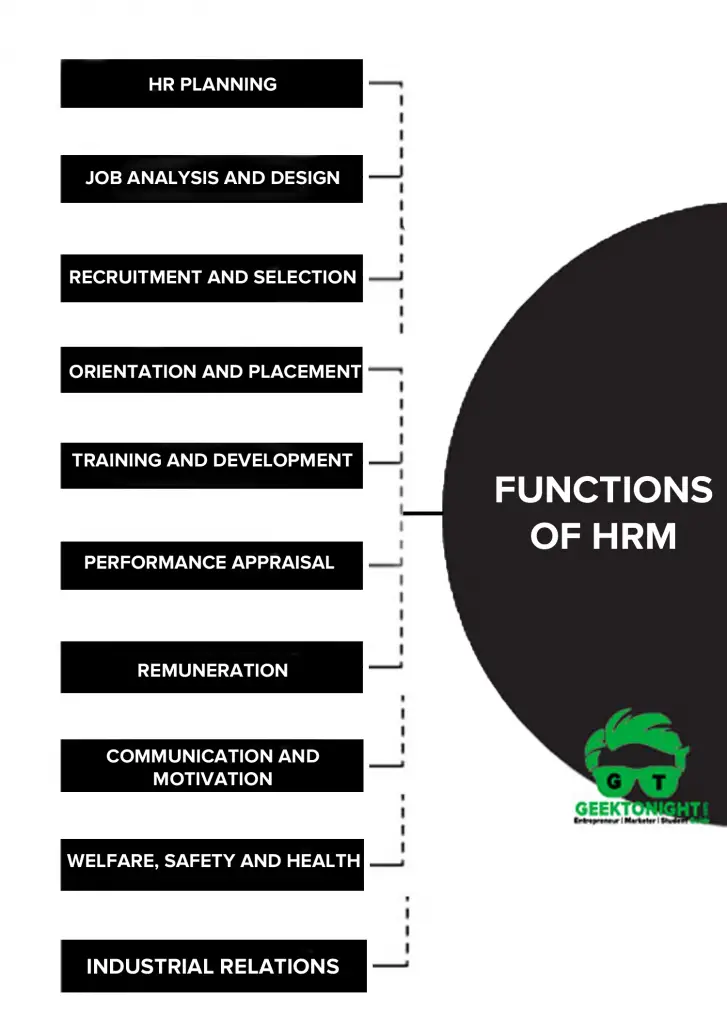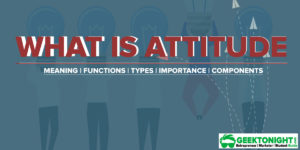Functions of HRM
Functions of HRM are:
- HR Planning
- Job Analysis and Design
- Recruitment and Selection
- Orientation and Placement
- Training and Development
- Performance Appraisal
- Remuneration
- Communication and Motivation
- Welfare, Safety and Health
- Industrial Relations
Table of Content

Functions of HRM are discussed below in detail:
HR Planning
Human Resource Planning is a process that identifies current and future human resource needs for an organization to achieve its goals. The objective of Human Resource Planning is to ensure the best fit between employees and jobs while avoiding manpower shortages and surpluses.
Job Analysis and Design
Job Analysis is the determination of the precise characteristics of a job through an in-depth and detailed examination of the activities to be performed. It does a detailed analysis of the tasks, activities, duties and responsibilities that are required to do a job.
It is the first step to successful human resource activities such as Human Resource Planning, Recruitment, Selection, Placement, Training, Performance Appraisal etc.
Job design allows job analysis. It involves designing the content of a job, it combines the tasks into a job to be assigned to an individual and further fixes the duties and responsibilities to do the job. While designing the job the needs of the organization and the needs of the individual manager must be balanced.
Recruitment and Selection
Once job analysis and job design specify the tasks and responsibilities of a job and the qualification required to perform it, it is followed by recruitment and selection. It is the process of hiring the right number of people of the right type at the right place.
Recruitment is the process of searching the best-qualified candidate from within or outside the organization in a cost-effective manner. It includes identifying and encouraging the candidates to apply for a job, receiving applications and screening them.
Once the applications are received after thorough examination the right candidate is picked from it. This process is called selection. It involves choosing the most aptly qualified candidate that best fits the job and can perform the task most successfully
Orientation and Placement
Orientation is the process in which the new employees are introduced and made familiar to their jobs, complex processes, coworkers and organizations.
Once the employee is introduced to the organization, he is then placed in a suitable job. It involves assigning the duties and responsibilities to the employee after matching the job requirement with the employee’s qualification.
Placement includes assigning tasks to new employees and the promotion or transfer of present employees. The new recruits for an initial period of time are put under probation to judge whether the candidate is fitting the job profile well.
Training and Development
Training is the process of enhancing the knowledge and skill of an employee required for a particular job. It improves the current performance of the employee and increases his knowledge base for higher-level jobs.
Development is an ongoing and continuous process that aims at improving the personality and attitude of employees.
- Training involves improving a specific skill of an individual whereas development aims at a broader picture and works towards improving the personality of an individual or work dynamics of a team.
- Training is required more on the staff handling the operations of a company whereas development is more common to the managers.
Performance Appraisal
Performance appraisal is the assessment of how well an employee has performed his assigned duties and responsibilities. The assessment is done on the results obtained by the employee and the output achieved by him in the past.
- Along with this the employee’s potential to grow in the future is also measured.
- Performance appraisal helps in making the employee aware of how well they are performing their job and guides them for future development.
- It helps in deciding the promotion and pay rise for each employee.
Remuneration
Payment or compensation received in exchange for the services or employment is termed as Remuneration.
- Remuneration consists of both monetary and non-monetary benefits. It mainly consists of the base pay also known as wage or salary.
- Indirect rewards are also provided such as retirement plans, vacation packages, health cover etc.
- Remuneration policies are well thought as it is the most important factor in attracting and retaining the employees. It should also make sure to maintain the internal and external equity to avoid dissatisfaction amongst the employees
Communication and Motivation
Effective communication is a very important contributor to the success of a business. It is very important that the mission, vision and objective of the organization are communicated to all.
Each employee needs to clearly understand his/her role and responsibility. They should also be formally or informally communicated about their performance and guided accordingly.
Motivation is a driving force that arouses the individual to work towards the desired goal with intensity, sense of direction and constant efforts. Each individual might be motivated with a completely different factor which should be carefully analyzed to energize these efforts.
Welfare, Safety and Health
Effective measures and programs ensure that the workplaces meet the health, safety and welfare needs of all the employees.
Health measures and regulation ensures that the mental, physical and emotional health of an employee is in a state of wellbeing.
Industrial Relations
Labour is one of the most important factors of production in any organization.
A healthy relationship between management and labour are very important to ensure uninterrupted manufacturing activities, reduces tension, conflict and unwanted violence.
- It helps in the smooth running of the organization and continuous work to the workers leading to the achievement of targets.
Hence there needs to be a healthy communication and friendly relationship between management and labor to be able to achieve higher efficiencies and higher profits.
Go On, Share & Help your Friend
Did we miss something in Human Resource Management Tutorial or You want something More? Come on! Tell us what you think about our post on Functions of HRM | Human Resource Management in the comments section and Share this post with your friends.
Human Resources Tutorial
(Click on Topic to Read)






